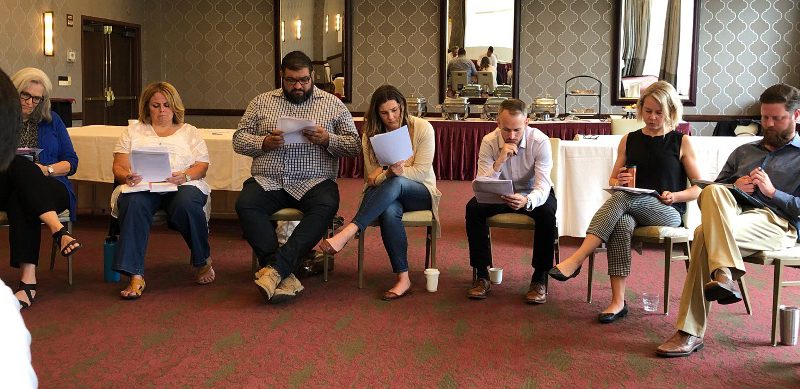Build a Culture of Facilitation to Grow Leaders
Here are stories of 3 project leadership teams whose skills grew simply from sharing facilitation responsibilities in standing meetings.
Team 1 – OAC rotating facilitators – small team: Team 1 was a relatively small off-site project on a billion dollar infill medical center in Northern California. Only 3 attendees at the weekly OAC (Owner-Architect-Contractor) meeting: the GC’s PM, the Architect’s PM and the Owner’s internal CM overseeing the project. I sat in on these meetings for several weeks observing that they were boring and draggy. The GC’s PM led the sessions capably but not enthusiastically. There were necessary issues and decisions to discuss, but all three seemed to be “checking a box”.
I suggested we shake things up: take turns facilitating the session, each of the 3 rotate weeks. The Owner’s CM quickly agreed. The architect’s PM said she wasn’t really good it, but would try it. I promised to coach her. Immediately the next session there was more participation and more energy, because the GC PM knew how important an engaged participant can be, so he was truly engaged. When it became the Architect’s turn, she stumbled a bit but did the job; we had met beforehand and done preparation. As the meeting progressed, so did her confidence and pace. In subsequent sessions, when it was her turn again she grew into the role. And the other two had first-hand experience needing engaged participants, so they both rose to the task.
This small team demonstrated how being challenged and coached in facilitation can improve both one’s own leadership skills as well as the skills of the participants. Ah, empathy!
Team 2 – OAC rotating facilitators – large team: Team 2 oversaw 70% of the aforementioned billion dollar infill medical center in Northern California. It was a big OAC with 20-25 people in every meeting. The agenda was long, the meetings plodding and long, people came and went during the session. It exemplified “death by meeting”. After the success of Team 1’s rotation I suggested to the Project Executive we do the same with the big group; he agreed it was worth a try. I then approached the GC’s Senior PM, who facilitated each session and pitched the idea, wary he would feel threatened by some imagined loss of status or power. I was wrong: he loved the idea, weary himself of the draggy pace and boredom he felt trapped in.
At the next weekly meeting the Senior PM pitched the plan and several vocal leaders agreed and offered to take turns. Letting it be the Senior PM’s idea and not mine, made a difference in the larger group.
Did it work? Yes. Again the key results are increasing empathy among participants who have taken their turn at the head of the room and a step up in pace and energy. This was a mostly more experienced group so while my pre-session coaching was of value, none wanted me to sit next to them for in-session coaching.
Team 3 – Trade Contractor Leadership Growth Team: A well-managed mid-sized electrical trade contractor had a standing committee of 15-17 “future leaders” of the company, meeting monthly, setting annual improvement goals and working toward them. The company VP asked me to sit in on their meetings, observe and coach wherever I could bring value. Early on we developed Ground Rules that promoted engagement and collaboration. I noticed all the meetings were organized, led and facilitated by one PM. He was a star, and a natural, but this was a team of stars in training. After a few sessions I suggested they take turns facilitating the session and I would help them prepare and coach them, sitting next to them as they facilitated.
From the very first rotation there was more energy in the room. A fresh face and pace. The participants respected and supported her offering to go first, and rose to the occasion with cooperation. The last agenda item was who would facilitate the next session…no hands…then 3 hands and the next 3 meeting facilitators were decided and the team grew in its effectiveness and spirit.
BOTTOM LINE: A big part of developing a Lean culture includes developing the leadership and facilitation skills of every member of the team. “See one, do one, teach one” is a valuable progression (usually replace “one” with “several” in the case of facilitation) – and combine it with training and coaching.
And a Tip for Continuous Improvement: peer-evaluation can be powerful. The Plus/Delta at the meeting’s end often includes some feedback on the facilitation. But we’ve also coached teams who shared the facilitation P-E-N for meetings, then – only for those facilitators who were open to it – solicited feedback from the group at the end of the session. Verbally from those who were so inclined, or on a Feedback Form in the back of the room for those who just wanted to offer simple check-box responses.

